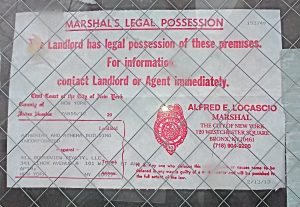 Our firm is involved in many situations in which one party seeks to remove another party from property, such as a house, cooperative, or condominium unit. However, the situation underlying the attempted removal will often determine the correct legal method for effectuating said removal.
Our firm is involved in many situations in which one party seeks to remove another party from property, such as a house, cooperative, or condominium unit. However, the situation underlying the attempted removal will often determine the correct legal method for effectuating said removal.
The two main legal remedies are an eviction action and an ejectment action. Keep in mind that there may be situations in which an experienced attorney needs to use his legal judgment to determine which type of action to bring. First, we will cover an eviction action.
Eviction actions are generally used in ordinary landlord-tenant matters. In most cases, there is a tenant who is renting property from the property owner, who is the landlord. There usually is a written lease, but not in all situations. There are generally two types of eviction actions. The first is a non-payment, in which the tenant has failed to pay her rent. The second is a holdover, in which the tenant’s lease has expired, or a situation in which the tenant never had a lease and has a month-to-month tenancy.
New York law provides for such cases to be heard in an expedited fashion in a Court which is generally set up for that purpose. Examples include City Courts, Town Courts, and Village Courts. These Courts allow for short return dates (usually within two or three weeks of filing), so that the cases can be heard quickly, with a fast resolution either by a trial or a settlement between the parties, which the Court “so orders.”
Ejectment actions seek the same relief as an eviction action; namely, a Court order allowing the City Marshal or Sheriff to remove an individual or individuals from the premises. However, ejectment actions usually, but not always, involve situations where there is no landlord-tenant relationship between the parties. Here are several examples. The first is when a property is foreclosed and sold to a new owner, but the original owner remains at the premises. In such a situation, the new owner may file a motion in the foreclosure case and seek a writ of ejectment.
Another example is in an estate matter. Let’s say the original owner of a property passes away. He may have left the property to a party not residing at the premises, or given an executor the power to sell the property and divide the premises among the named heirs. There may be individuals residing at the premises who refuse the leave the premises, even though their right to reside there terminated when the original owner died. In such cases, the estate’s executor or administrator may bring an ejectment action to remove the occupants from the premises, so that the premises can be sold, and the proceeds distributed to the heirs.
Unlike ordinary eviction actions, ejectment cases are generally brought in the Supreme Court, or where an estate is involved, may also be brought in the Surrogate’s Court. It should be noted that such cases will not have an expedited resolution, as would an ordinary eviction case. Ejectment actions will proceed through the Court system as any other civil litigation, and may take significantly longer to resolve than an eviction case. However, in some situations, an ejectment action may be the sole remedy, depending on the underlying facts and statutory interpretation.
Our firm has handled litigation of both eviction and ejectment actions, and welcomes all inquiries from parties looking to remove parties from property, or defending those who have had such actions filed against them.
 New York Real Estate Lawyers Blog
New York Real Estate Lawyers Blog

